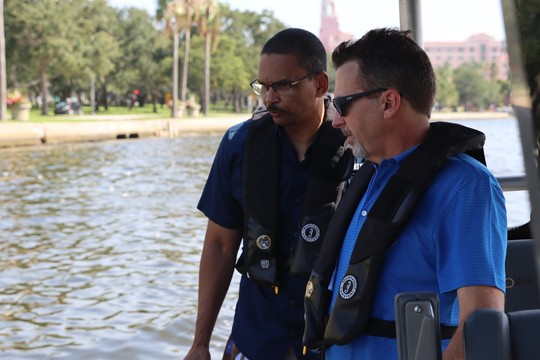FOR IMMEDIATE RELEASE: July 13, 2021
FWC and DEP Host Roundtable to Discuss Florida’s Efforts to Combat Red Tide
~ Funding available for red tide response and monitoring ~
 ST. PETERSBURG, Fla. – Today, Florida Fish and Wildlife Conservation Commission (FWC) Executive Director Eric Sutton and Florida Department of Environmental Protection (DEP) Interim Secretary Shawn Hamilton joined affected stakeholders to discuss Florida’s multifaceted efforts to combat red tide. During the roundtable, hosted at the FWC Fish and Wildlife Research Institute, DEP highlighted funding it is allocating to bolster local response efforts mitigating the impacts of red tide in the greater Tampa Bay area. In response to this red tide event, the state has been engaged with stakeholders and is in the process of executing grant agreements with Pinellas and Hillsborough counties.
“Having spent much of my life in Southwest Florida, I know that red tide blooms can cause significant impacts to our local communities,” said FWC Executive Director Eric Sutton. “Today, DEP Interim Secretary Shawn Hamilton and I were able to view firsthand the impacts of the current bloom in the Tampa Bay area. We also spent time with stakeholders and local leadership to ensure we are providing information, scientific data, and the latest efforts of all partners regarding red tide research and management. Since his first day in office, Governor Ron DeSantis has been a staunch advocate of improving our state’s water quality, dedicating significantly more funding and resources for red tide research and management. This support is critical as we join together for a long-term approach to complicated ecological issues.”
“Algal blooms have the ability to impact environmental health as well as the economic health of our communities,” said DEP Interim Secretary Shawn Hamilton. “Today, we were able to hear directly from stakeholders about their needs and ways we can enhance our collaborative efforts to combat red tide. Effectively addressing these impacts requires an all-hands-on-deck approach at both the local and state levels. Thanks to the leadership of Governor DeSantis, DEP is able to provide funding assistance to our local partners for monitoring and mitigation solutions.”
“While red tide has existed for centuries, we know that excess nutrients in our coastal waterbodies exacerbate and encourage the presence of harmful algal blooms, including red tide,” said Florida Chief Science Officer Dr. Mark Rains. “The Blue-Green Algae Task Force is committed to working with the Harmful Algal Bloom Task Force to identify gaps in our understanding and develop strategies based on sound science and thorough research to mitigate both the short- and long-term effects of harmful algal blooms.”
Upon taking office, Governor DeSantis outlined a bold approach to tackle Florida’s critical water issues in Executive Order 19-12 (Achieving More Now for Florida’s Environment), including the reactivation of the long-dormant Harmful Algal Bloom Task Force. Under the Governor’s direction, the task force adopted an initial short-term, top-priority focus on key issues associated with red tide. The task force continues to meet at least quarterly to further the state’s efforts to combat red tide.
Since 2019, the state has dedicated more than $14.5 million to the Center for Red Tide Research at FWC which was created in 2019 at Governor DeSantis’ request. Additionally, in his first legislative session, Governor DeSantis signed into law Senate Bill 1552, which established the Florida Red Tide Mitigation and Technology Development Initiative, a partnership between FWC and Mote Marine Laboratory to develop technologies and approaches to control and mitigate red tide and its impacts. Senate Bill 1552 provided a $3 million annual appropriation to the initiative for six years, totaling $18 million.
Learn more about what the state is doing to protect Florida's waterways and stay up-to-date with real-time water quality status at ProtectingFloridaTogether.gov.
|